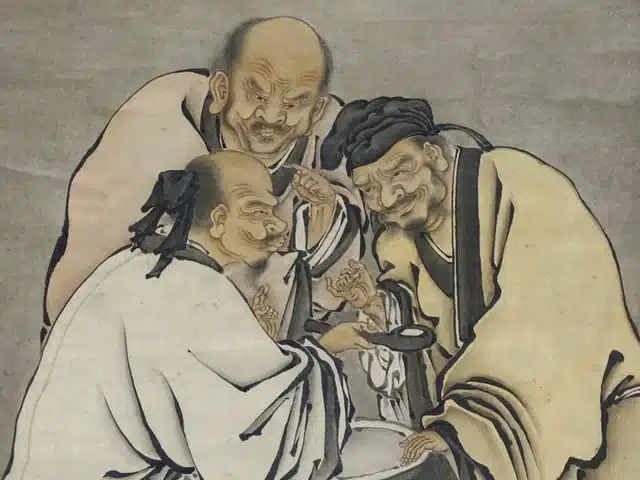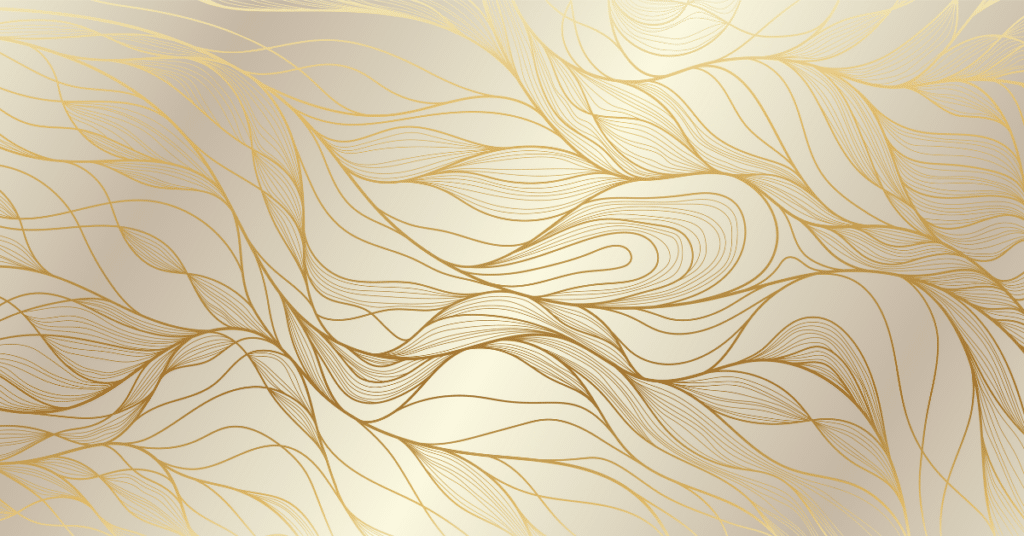The Vinegar Tasters is a famous Chinese painting depicting three men standing over a vat of vinegar. They each have dipped a finger into the vinegar for a taste, and the man on the left has a puckered, uncomfortable expression—he finds the vinegar very unpleasant. The man in the middle is in the same boat. He thinks the vinegar is gross. But the man on the right, curiously, has a knowing smile. Somehow, he finds the taste of vinegar, or the whole situation, amusing.

What is it about the third man’s perspective that turns the taste of vinegar into a pleasant experience?
These three characters, from left to right, are known to be the founders of China’s three major religious and philosophical bases: Confucianism, Buddhism, and Taoism—making these men Confucius, Siddhartha Gautama (Buddha), and Laozi.
China’s Three Schools Of Ancient Thought
Confucius, on the left, believed that humans are naturally good people, but in desperate need of order. Laws, edicts, and structures of control were thus needed in order to prevent society, and humanity at large, from degenerating. His focus remained, and the focus of Confucianism at large to this day remains, on using structure and order to improve life.
Confucius’s expression in The Vinegar Tasters painting is thought to be a reflection of his distaste for disorderly things and for the modern world in general. His belief is that the ancient ways were best, and that the modern world, and its lack of order and lack of focus on rituals, has made it difficult to enjoy life. Understandably, this makes it easy for him to taste the bitterness in the vinegar.
Buddha, in the middle, takes a slightly different approach to life—but arrives at the same sourly state. Buddhism is based on the principle that people are inherently good, but that life is full of suffering due to our attachments to desire, thirst, and other earthly desires, or tanha. It is the work of Buddhists to eliminate tanha and escape the cycle of death and rebirth. (If you are familiar with the tenets of Hinduism and the lessons of the Bhagavad-Gita, this will sound familiar. Buddhism has its roots in Hinduism, as Siddhartha was born into a Hindu family.)
Which leads us to Buddha’s reaction to the vinegar: equal to the look of distaste on Confucius’s face. Buddha, despite having a slightly more optimistic view of the world, nonetheless holds a view of life that has an air of escapism; life is full of suffering, and the only way to escape it is to detach ourselves from our worldly desires. His expression in The Vinegar Tasters reflects many things; first, that the vinegar tastes unpleasant. This shows a realistic view on the world, but also, in my opinion, it shows that Buddha himself was attached to a desire for good-tasting things.
It’s not until we reach the third and final man in the painting—Laozi—that we see a positive, and almost amused, expression.
Laozi is the ancient author of the Tao te Ching, the foundation of Taoist philosophy. It is the lessons contained in the 81 short chapters of his book that explain why his expression is so far removed from the other two men.
The Taoist approach to life is one of acceptance and balance. Good and bad don’t exist; these are judgments of the mind, and the mind is susceptible to extremes. Rather, to live a life of enlightenment, one must “go with the flow” and find the beauty, gratitude, and peace in every moment—including those which our senses or emotions tell us are otherwise unpleasant.
This acceptance of what “is” is what causes Laozi to have a smile on his face. He tastes the same vinegar as the other two men, but he finds the unpleasantness interesting. He may even find the situation of the other two men wincing amusing, knowing that he has an approach to life which is free from the structures of control that dominate the other two men’s mindsets.
Loosen Your Grip On Life
We cannot control the taste of vinegar in the same way we cannot control anything else outside the realm of our own mind. Embracing the unpleasantness or chaos, rather than trying to control it, is the key to living freely. This doesn’t mean you allow your life to be chaotic; rather, you become aware of, and subsequently engineer forms of control and structures in your life which enable you to pursue your purpose, be of service to others, and remain present in every moment—without attaching yourself to the outcome intended by that control and those structures.
For example…
Let’s say you decide to reorient your schedule to make more time for family activities, like dinners and going to soccer games. This is a form of exercising control over elements of the universe that are out of your control, all for the purpose of enjoying life.
Anything can happen now. Your car may break down, your client or boss may call you last minute, your kid may be invited last minute to a party, or any number of events could occur which get in the way of having more family time.
In these moments, you have a choice. Either you get upset over the fact that things didn’t go according to plan, or you accept that you never had control over the circumstances in the first place. Choosing the second option—that of the Taoist way of living—leads you to a happier, more open, more curious, and less stressed way of thinking.
Because over time, those structures will work. You’ll eventually have more family time. You’ll get home earlier, on average, and spend more time with your spouse and/or kids. You’ll achieve your goal! But on the days when you don’t, detaching from the outcome you set for yourself, acknowledging that you never had control over extenuating circumstances, will free you from the frustration and distaste that plague men like Confucius and Buddha.
Common Structures We Attach Ourselves To
We attach ourselves to the outcome of countless structures in our lives. Take time and speed, for example.
According to legend, Galileo lit upon the idea for a pendulum clock when sitting inside Pisa’s cathedral. He began counting the oscillations of the chandelier against his own heartbeats, ultimately realizing the two patterns were in sync with each other. This is the basis of how pendulum clocks actually work—they measure seconds relative to the movement of a well-balanced device, like a swinging pendulum.
The passage of time can only be measured in relation to something else in the same way a car’s speed can only be measured relative to the ground. But what if we considered the car’s speed relative to the center of the solar system? Now the car’s speed would have the orbital speed of the Earth around the sun (about 67,000 mph). Similarly, if we began to measure seconds relative to a slower device, like a single rotation of the Earth, a second would become what is currently a day—and the measurement of time would lose its value.
Measurements of speed and time, therefore, are structures we have invented in order to create a sense of control over our world. Of course, we gain many benefits from this control, including our mastery of physics and technology. But the fact remains the same that they are constructs of the human mind.
A wild animal has no sense of how many minutes have passed, nor does it know what year it is. Life, to every other living thing on Earth, is simply an endless series of cycles of sleeping and hunting or foraging. Imagine humanity without the structure of time to keep us organized. Most of society would collapse. So, in many ways, these structures are gifts. But they can also be curses, keeping our minds trapped by what should be.
You’re late for a meeting. Someone else is late for your party. The person in front of you on the highway is driving too slowly. Your spouse is taking too long to get dressed. A package is delayed in arriving at your house. Any number of situations can occur that highlight the sense of control that the structure of time gives us—and how fleeting that sense of control can be.
What if we released that control? What if we accepted that things progress as they need to, without worrying about how fast they progress relative to minutes or hours, which are themselves simply progressing relative to a swinging pendulum? Are we all slaves to a simple pendulum, or can we accept that the world is a fluid, changing, and dynamic place that doesn’t care how we measure its progress?
Structures of control exist all around us if we choose to see them as such. Money, social networking, our expectations of others, and even organized religion are all inventions of the human mind—constructs that provide value to us in very real ways, but which also lead us into a happy delusion that life isn’t as wild and unpredictable as it actually is.
What would happen if you loosened your grip on these constructs? How would your life change, how would your definitions shift, how would your assumptions evolve, if you relaxed your expectations of the structures that were invented for nothing more than to give us the illusion of control? What might change?





